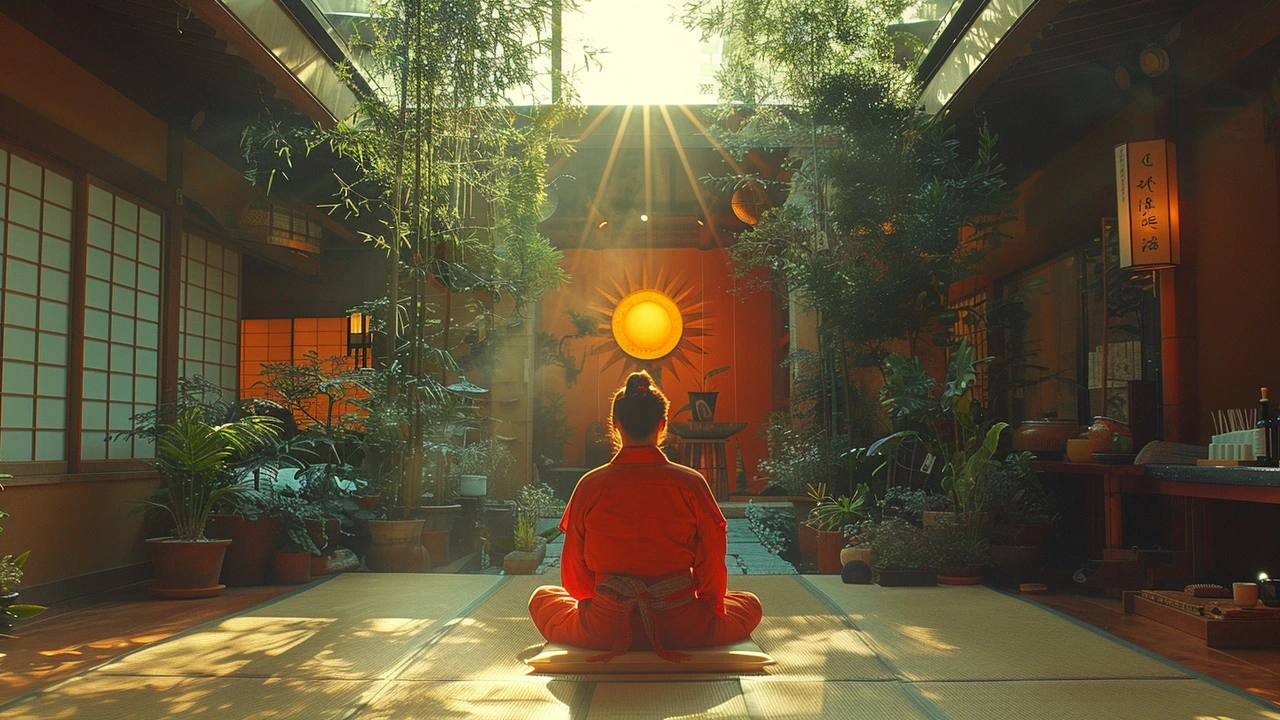Shiatsu, a traditional Japanese technique, is not just a massage. It’s an ancient practice aimed at balancing the body’s energy.
Originating in Japan, Shiatsu translates to 'finger pressure' and involves pressing on specific points on the body. This technique not only helps in relieving stress but also promotes healing and rejuvenation.
Let’s dive deep to uncover the mystical beauty of Shiatsu and how it can bring harmony and health into your life.
- Understanding Shiatsu
- Benefits of Shiatsu
- How Shiatsu Works
- Practical Tips for Incorporating Shiatsu
Understanding Shiatsu
Shiatsu is much more than just a massage technique; it is a holistic approach to health that seeks to balance the body's energy flow or 'Qi.' Originating from Japan, it integrates elements from traditional Chinese medicine, such as acupuncture, though without the needles. Instead, Shiatsu relies on the practitioner's hands, palms, and fingers to apply pressure to specific points on the body.
The term 'Shiatsu' itself means 'finger pressure,' and this speaks directly to its methodology. It was formalized in the early 20th century by Tokujiro Namikoshi, who combined various Asian techniques to develop what we now recognize as Shiatsu. His approach aimed to stimulate the body’s inherent ability to heal by focusing on certain pressure points.
One of the essential principles of Shiatsu is that it aims not only at relieving physical pain but also at addressing emotional imbalances. By working on meridians or energy pathways, Shiatsu practitioners believe they can unblock stagnant energy, promoting better overall health. This idea is rooted in the understanding that physical symptoms often have an underlying emotional component.
As Tokujiro Namikoshi once said, "The heart of Shiatsu is like pure love." This quote encapsulates the compassionate nature of this practice, emphasizing a therapeutic relationship grounded in care and respect.
Shiatsu also involves a diagnostic aspect. Practitioners often assess areas of tension and imbalance through touch and observation, adjusting their technique based on the body's response. This personalized approach makes each Shiatsu session unique, tailored to the individual's specific needs.
Modern research supports many claims of Shiatsu's benefits. Studies have shown that Shiatsu can reduce stress, improve circulation, and enhance emotional wellbeing. A survey conducted by the European Shiatsu Federation found that 89% of recipients reported improved health after a series of treatments. These benefits make Shiatsu a compelling option for those seeking a natural method to support their health.
Understanding Shiatsu fully requires experiencing it. While descriptions can provide a foundation, the true essence of Shiatsu becomes apparent when one feels the gentle, yet firm pressure and the subsequent release of tension. Whether it's relief from chronic pain or simply a way to relax, Shiatsu offers a profound way to reconnect with your body’s natural rhythms.

Benefits of Shiatsu
Shiatsu has captivated the hearts of many due to its numerous health benefits. This ancient practice focuses on aligning the body’s energy pathways, known as meridians, to enhance physical and emotional health. One of the most celebrated benefits of Shiatsu is its ability to provide relief from stress. By applying pressure to specific points, shiatsu practitioners help stimulate the body's parasympathetic nervous system, which is responsible for restorative functions. This process can lead to a significant reduction in stress levels and promote a state of calmness.
Besides stress relief, shiatsu can help alleviate chronic pain. For those suffering from back pain, neck stiffness, or joint issues, this technique offers a natural alternative. The finger pressure used in shiatsu promotes circulation in the affected areas, reduces inflammation, and helps to release muscle tension. An improved blood flow can speed up the healing process, making it effective in pain management. According to a study published in the Journal of Alternative and Complementary Medicine, individuals who underwent shiatsu therapy reported noticeable pain relief and improved quality of life.
Another notable benefit of shiatsu is its ability to boost immune function. With the world increasingly becoming aware of the importance of a strong immune system, shiatsu presents itself as a viable option. By promoting better circulation and reducing stress, shiatsu can help improve the body’s overall immune responses. Additionally, some believe that the practice helps to balance the body's energy, making the system less susceptible to illness. It’s no wonder many people turn to shiatsu for help during the flu season or when they feel run down.
Mental health improvement is also a crucial benefit associated with shiatsu. Regular sessions can result in better sleep patterns, reduction in anxiety, and help combat depression. By balancing the body's energy, individuals often feel more grounded and centered post-treatment. This holistic approach not only addresses physical ailments but also extends to mental well-being. Noting the holistic benefits, Dr. Nishimoto from the International Association of Shiatsu Professionals remarked,
"Shiatsu offers a phenomenal way to harmonize the body's internal energy, leading to profound mental clarity and physical relaxation."
Lastly, shiatsu improves flexibility and posture. Since this practice involves stretching of limbs and joint rotation, it helps to maintain or even increase the range of motion. People who sit for long hours or engage in repetitive activities often find their posture improving after several shiatsu sessions. They experience enhanced mobility and lesser joint discomfort. Thus, shiatsu serves as both a preventive and remedial measure for many muscular-skeletal issues.

How Shiatsu Works
Shiatsu operates on the principle of balancing the body's energy, known as Qi (pronounced 'chee'). According to traditional Chinese and Japanese medicine, Qi flows through pathways in the body called meridians. The smooth flow of Qi is essential for maintaining health, and blockages or imbalances can lead to illness or discomfort.
The practitioner uses their fingers, thumbs, palms, and sometimes elbows or knees to apply pressure to specific points along these meridians. This targeted pressure helps to unblock stagnated energy, allowing it to flow freely. It's like opening up a highway that was previously jammed with traffic. The release of these blockages can bring about a profound sense of relief and wellbeing.
Shiatsu sessions typically last about an hour. During this time, the practitioner might also incorporate stretching and joint manipulation techniques. This combination not only targets the energy pathways but also promotes flexibility and relaxation.
Unlike other forms of massage, Shiatsu is usually performed on a futon mat on the floor, and clients remain fully clothed. This makes it less intrusive and allows the practitioner to use their body weight effectively to apply the right amount of pressure.
A 2008 study published in the 'Journal of Alternative and Complementary Medicine' showed that regular Shiatsu treatments could significantly reduce stress and improve overall quality of life. The study highlighted that clients experienced reduced anxiety levels, better sleep, and improved mood post-treatment.
“Shiatsu is not just about working on the physical body; it’s a holistic approach that addresses the mind and spirit as well,” says Victoria Abbott-Fleming, a well-known Shiatsu therapist.
Moreover, Shiatsu can be customized to suit individual needs. The practitioner assesses your energy flow and tailors the session to address specific issues, whether it's chronic pain, digestive problems, or emotional stress.
One remarkable aspect of Shiatsu is that it’s not just for the unwell. Even if you’re in good health, regular treatments can serve as a preventive measure, keeping your energy balanced and your body tuned.
So, the next time you feel out of sorts, consider trying Shiatsu. Through a combination of pressure, stretching, and joint manipulations, Shiatsu aims to restore balance and promote self-healing. It’s a practice that respects the intricate balance of the body’s energy systems, making it a powerful tool for maintaining health and wellbeing.

Practical Tips for Incorporating Shiatsu
Integrating Shiatsu into your daily routine can offer a myriad of benefits, ensuring that both your mind and body stay in harmony. Here are some practical tips you can follow to make the most out of Shiatsu.
First, consider finding a qualified Shiatsu practitioner. A professional will know the right pressure points and techniques to use based on your unique condition and needs. It’s always helpful to have at least a few sessions with a licensed practitioner to get a good understanding of how Shiatsu works. You can then try translating some of these techniques into your self-care routine at home.
For a DIY approach, start by learning basic Shiatsu techniques. Focus on pressure points along the meridian lines of your body. The key areas include your back, neck, hands, and feet. Applying consistent and gentle pressure using your fingers, thumbs, or palms can help to stimulate these points. It’s important to perform these techniques while keeping a relaxed state of mind, as relaxation facilitates the flow of energy.
Another useful tip is to integrate Shiatsu into your morning or nightly routine. Spending just 10 to 15 minutes on self-Shiatsu can help prepare your body for the day ahead, or wind down after a long day. You can combine these sessions with deep breathing exercises to enhance relaxation and boost energy flow. Consistency is crucial, so try to make it a regular part of your schedule.
It’s also beneficial to maintain good posture and body mechanics during the day to complement the effects of Shiatsu. Poor posture can create blockages in your energy flow, causing ailments and discomfort. That's why incorporating simple stretches and maintaining a balanced diet can further enhance the benefits of Shiatsu. Eating fresh, nutritious foods and staying hydrated helps in boosting overall energy levels and supporting the body’s natural healing processes.
“Few therapies come close to providing the profound relaxation and rejuvenation that Shiatsu delivers.” — Dr. Susan Wilson, Health & Wellness Expert
Finally, consider joining Shiatsu workshops or classes where hands-on practice is provided. Engaging with a community can motivate you to stick with your journэy and learn new techniques. Sharing your experiences and learning collectively can be both exciting and fulfilling.
Combining these tips with a mindful lifestyle can make a significant difference in your wellbeing. Remember, consistency and awareness are the cornerstones of harnessing the true power of Shiatsu. Explore, experiment, and above all, enjoy the journey of energy balance.


 Health and Wellness
Health and Wellness